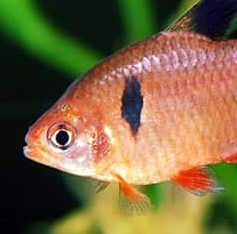Serpae tetras are famous flame-colored fish that swim through your aquarium in vivid red schools. Because of their beauty and ease of maintenance, they're highly popular in community aquariums, though they can be moderately aggressive when kept with slow-moving species. Add a group of 6 to 8 serpae tetras to your tank, along with plants, gravel, and caverns, and enjoy watching them explore freely in the tank.
The serpae tetra is typically regarded as a calm fish, and should always be housed in groups of at least six. They have been known to nip fins in smaller groups, an aggression that is most commonly targeted at their own species, particularly during feeding times.
Other energetic fish of similar or greater size, such as barbs, danios, and larger tetras, make excellent tankmates. Loaches and bottom-dwelling catfish are also good tankmates. Keep this variety away from fish with long, flowing fins or that move slowly, such as angelfish or bettas. Avoid raising them with smaller fish to prevent bullying. Serpae tetras are more likely to bite at feeding time, so spread out the food or use numerous feeding rings to assist in decreasing nipping.

Male vs Female Serpae Tetra Fish Difference
The differences between sexes are subtle and are most noticeable when serpaes are prepared to spawn. Males have a brighter coloration and are thinner, with a totally black dorsal fin. Females have a paler dorsal fin. Even when they aren't spawning, females have a broader physique.
Males are smaller than females, however, they have a bright red coloration. Females are often dull red and spherical, particularly during the breeding phase, when they become significantly larger than males.
Serpae Tetra Care
A tropical Amazonian setting is ideal for the serpae tetra's habitat. This fish is adapted to tranquil waters with roots and organic material in the habitat. The use of peat or blackwater extract helps to recreate this type of soft, acidic water.
It is recommended to use a dark-colored substrate and moderate illumination. Maintain an open swimming area by surrounding it with driftwood, plants, and décor to create hiding places. Maintain steady water flow within the tank. Because they are sensitive to changes in water parameters, serpae tetras are not suggested for newly set-up aquariums, despite the fact that they are easy to maintain.
Serpae Tetra Breeding
Serpae tetras can be easily bred in pairs or in groups with nearly equal numbers of males and females. Setting up a tank with the correct ecosystem for breeding and continuous fry growth is critical to successful breeding.
Set up a small tank with a dark substrate, low illumination, and breeding mops or fine-leaved plants like java moss or Myriophyllum. The water should be very soft, with a dGH of no more than 8 and a pH of around 6.0. Filtration should be mild, such as using an air-driven sponge filter. Maintain a temperature of 80 °F in the water.
Provide a range of foodstuffs to the breeding couple, including live items if possible. When it's time to spawn, males will get more colorful and females will become significantly plump. Eggs will be dispersed across the vegetation or spawning area. Remove the adults once the eggs have been laid, as they will swallow the eggs. Turn off all illumination in the tank, as the eggs are extremely light-sensitive.
The eggs will hatch in 1 to 2 days, after which they will feed for several days on their yolk sack. They will feed on infusoria and newly hatched brine shrimp once they are free-swimming.









0 Comments